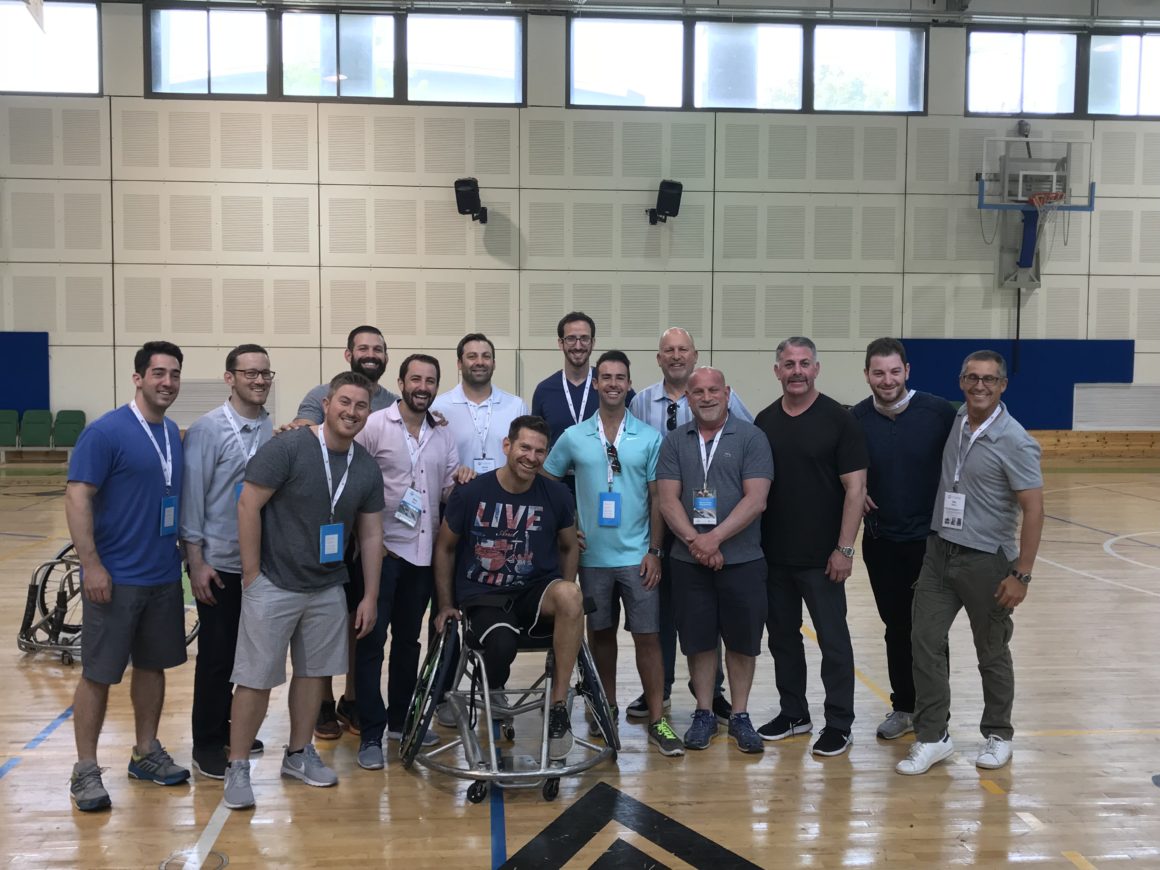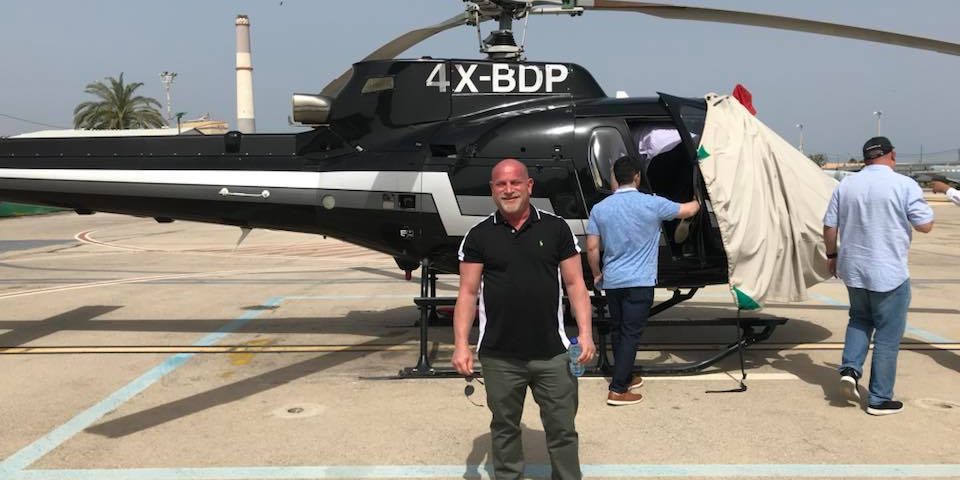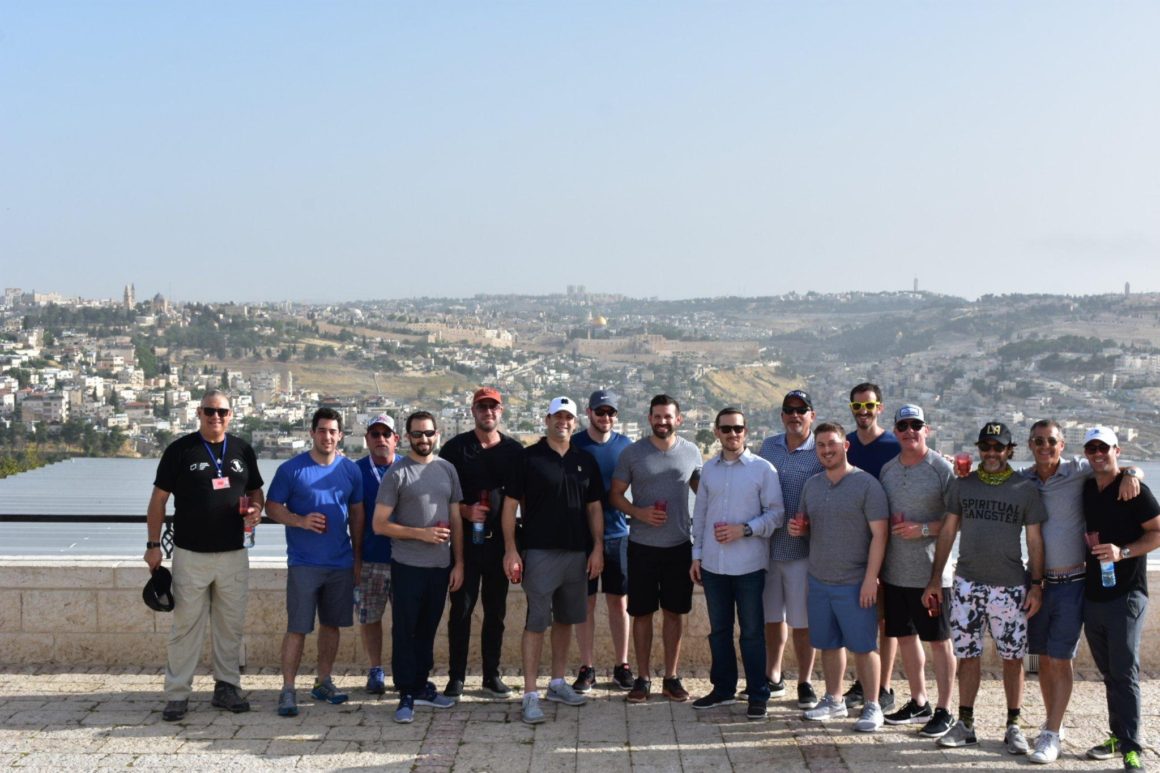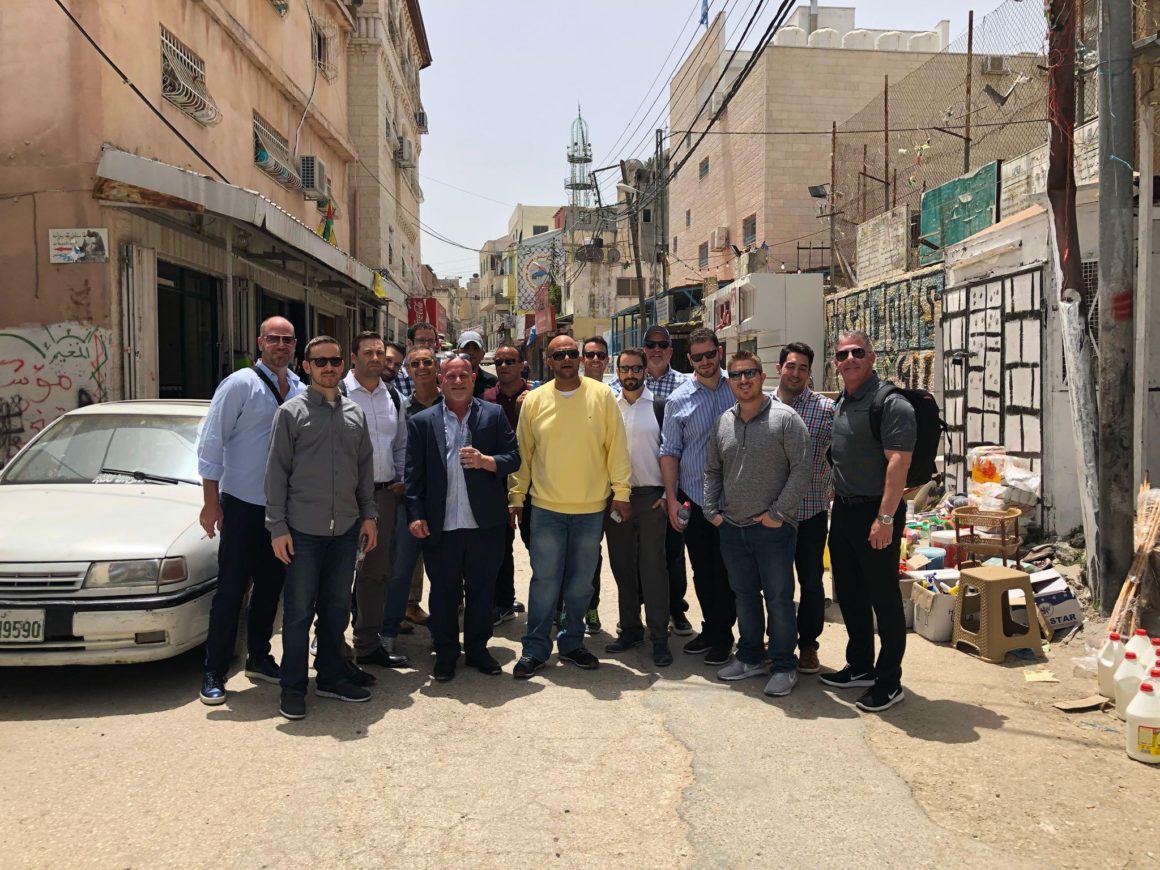Pictured above: Marty Haberer, CEO of the Jewish Federation of Greater Phoenix, gets ready to board a helicopter in Tel Aviv.
The Jewish Federation of Greater Phoenix is hosting a men’s mission in Israel to see first-hand the work Federation funds through its overseas partners, including JAFI and the JDC. The mission is co-chaired by Steve Hilton and to Jay Stein. The men are sharing their daily adventures in Israel.
Day 2 – Tel Aviv
By Blaine Light
We started the day with a wonderful Israeli breakfast and listened to Alon Ben David, senior defense correspondent for Israel’s Channel 10 news, who gave an insightful overview of the geopolitical situation in Israel, particularly regarding Syria, Iran and the Palestinian conflict.
We then played wheelchair basketball at the JDC-Accessible Health Zone. My team lost, but I did get a basket ;)!
We then walked Tel Aviv’s 70 Years of Independence Trail, where we learned the history of Tel Aviv. Did you know that Israel’s largest city was built on sand dunes and muck? From draining the swamp, they were able to build the city.
Schools were very important, so a school was built as the center of the community. And while some things are new, some things never change. The name “Tel Aviv” means old and new city; old from Tel (ancient mount), and new from Aviv (spring). It’s a poetic and appropriate name for a blossoming city based on deep roots to the land.
We had a meat-filled lunch at “A Place to Meat” with property developer Danny Herzog, who shared what it’s like to be a developer in a socialist country where 93% of the land is owned by the government and where apartment prices (per square foot) are higher than New York City – very interesting. We then got nerdy and visited “The Bridge,” a tech company that connects Israeli startups with major brands like Coke and Mercedes, to give them early (and powerful) customers who help them launch.
After a long day, we returned to the hotel to relax or nap, then we went to dinner and a whiskey tasting in the historic Sarona neighborhood, and headed home for a good night’s sleep.

Day 3 – Touching Syria
By Ben Ellis
We started the day with breakfast with former U.S. Ambassador to Israel, Dan Shapiro, who shared his experience as an ambassador during the Obama administration.
Yesterday, when Alon Ben David (a reporter for Israel’s Channel 10) heard we were going to the Syrian border in the Golan Heights (northeast of Israel), his eyes opened wide and said, “They’re not going to let you up there.” But our amazing guide for the day, Ret. Colonel Kobi Marom was able to pull some strings, and he brought us right up to the Syrian Border. We saw the Shouting Hill, where Arab and Druze families in Syria would use megaphones to communicate with their family members on the Israeli side of the fence and Israeli families would reply in kind. We then were hosted by a wonderful Druze woman who made an incredibly tasty meal. We were surprised to hear that next week she is visiting her daughter who lives in San Francisco!
After lunch, Kobi brought us to Sh’ar Yishuv to share the story of a horrific helicopter accident during the second Lebonan War – two helicopters full of Israeli soldiers turned their lights off as they headed into the enemy zone, then crashed into each other a few seconds later, tragically killing 73 on board. Incredibly, Kobi was the commander of the unit at the time of the accident, and in true Jewish fashion, he led through the grieving process by encouraging the soldiers’ friends and families to share their sorrow and mourn their losses.
We hopped back into the helicopters and headed west to the Western Galilee Medical Center, the only hospital in Israel that has a fully functional underground hospital: 500 beds above ground and 200 underground. We met with the Director of the hospital, Dr. Masad Barhoum. Dr. Barhoum is a Christian Arab that runs an Israeli hospital, and says with his whole heart that Israel is his country, and he is proud to be helping people that are Jewish, Christian, Muslim, Israeli and Syrian. His saying is “Adam, Le’Adam, Adam” which loosely translates to people helping people because we are all people.
Kobi then took us underground where we were met by three Syrian patients. No one in the hospital knows their true names, what side they were fighting for or anything else that would create a potential conflict. Their vision is purely humanitarian – to help individual people in need.
We got a chance to ask a few questions. One question was “How did you feel about Israel before coming here and how do you feel about Israel now?” A Syrian patient essentially said that when he lived in Syria, he was educated that Israelis did not allow Arabs in Israel and those that entered were killed. Now, he has a different opinion of Israel, and when he returns to Syria (post-recovery), he will speak (and has already begun to) with his friends and family to change the paradigm and spread his appreciation and respect for Israel.
After flying back to Tel Aviv, we had dinner with one of the foremost experts on Iran in the world, Prof Uzi Rabbi, who shared with us the challenges of the region from a different and deeper perspective. He spoke about the concept of “hot peace” and “cold peace.” Cold peace is peace that is not necessarily friendly, but peace nonetheless, whereas hot peace is a friendlier peace where commerce and warmth grow with time. The key takeaway is that regional Arabic players (Saudi Arabia, Jordan, etc.) need to help to create a lasting peace in the region.

Day 4 – Gaza
By Ben Ellis
We started today with MK Gideon Saar, who may be running for Prime Minister in the coming elections.
We then traveled to Aleh Negev to meet with Maj. Gen. (Res.) Doron Almog. Aleh Negev is a beautiful place where those with severe special needs have a full-time home, as well as a rehabilitation center for seniors, soldier, and anyone who needs it. They create 450 medical jobs, have 400 volunteers, and have built a beautiful (and fully handicap-accessible) campus, including a huge amphitheater, an indoor swimming rehabilitation pool, and facilities that convert to bomb shelters to protect against incoming rocket fire. Truly a miracle in the Negev (southern desert region) of Israel.
We then drove to the Otef Azza region (the region surrounding Gaza) to meet with Col. (Res.) Grisha Yakubovich, who took us to a makeshift rocket museum, which was really a collection of hundreds of rockets fired against Israel. We learned how the Israeli government gives Gaza materials like fertilizer for farming and pipes for irrigation, and Hamas (the terrorist group that controls Gaza) uses those items to build and fire 19,000 rockets against the Israeli citizens. They also build underground tunnels from Gaza, penetrating into the Israeli cities and kibbutzim along the border, causing terror, making the children in the area get PTSD, and murdering and maiming many innocent victims. Imagine if Mexicans were firing thousands of rockets a month across the border– would the United States allow them to do that? Also, people say, why don’t you just move away from the border? To reiterate – these are normal citizens living in normal homes within Israel (not settlements), and they can’t just pick up everything (house, jobs, community) and leave. And if they did leave, there would be rockets shot further (some rockets were shot towards Tel Aviv in the last war), so there is no escaping the rocket fire for Israelis.
After the rocket museum, we went to a lookout where we saw Gaza less than a mile away. The situation in Gaza is complex. Hamas is in power now. They are very smart, and have rallied their people around the idea that Israel is the enemy and must be eliminated. In the recent shootings along the border, in the first two weeks, 19 people were killed. As it turns out, 15 of those 19 were self-proclaimed (on Arabic television and other sources) terrorists. Imagine if tens of thousands of Mexicans were all trying to cross the border illegally at the same time – would the United States allow them to enter?
Our time at the lookout was cut short as we heard gunshots very close to us which as you can imagine standing on the border where there is an active conflict is a bit scary. To the best of our knowledge, Israeli snipers were shooting in the direction of Gaza. We heard later than one person was killed and three were injured cutting the fence and trying to cross the border. We left the lookout as our guide thought it was possible that there may be a retaliation, and as a large group in the open, we could be an easy target.
The issues are easy to box into black and white conditions, but the reality is, it is a complex and ever-changing environment that deserves special education and attention to the issues to best understand the conflict and the region.
We spent dinner with the deputy mayor of Jerusalem, Ofer Berkovitch, who is an inspirational young figure running for mayor of Jerusalem in the upcoming election. He is at the head of the wake-up movement which has created momentum in Jerusalem to develop more infrastructure, affordable housing, vibrant culture through arts, music and food and is truly a charismatic leader that our guide Doobie even shouted at the end of dinner, “You have my vote!”
Day 5 – Overlooking and entering the West Bank
By Blaine Light
We started our morning driving to the border between Jerusalem and the West Bank. We visited a few lookout points, at each one our guide, Colonel Ron Shatzberg, described different pieces of Jerusalem’s rich and challenged history. At one lookout point we could see Bethlehem and one of the largest Israeli settlements inside of the West Bank. Listening to Colonel Shatzberg retell his story about leading a battalion during the second intifada – his soldiers were being shot at and rockets fired towards by Palestinians in Bethlehem, yet they shielded themselves by civilians so as to create a human shield, and preventing retaliatory fire from the Israeli soldiers. Colonel Shatzberg knew his unit was capable of entering Bethlehem and requested permission to do so. His unit was instructed by then Prime Minister Perez to hold their position and NOT enter Bethlehem as his existing agreement with Yasser Arafat was Israeli soldiers will not penetrate into cities in the West Bank and Palestinian military forces were to resolve the radical Islamist element internally.
We then traveled inside of the West Bank to an Israeli settlement, Efrat, where we had an inspired lunch with Mayor Oded Revivi. Mayor Revivi’s sentiment is that Jews and Arabs must live side by side without borders in order to find a path to peace.
He told us a story about how his Palestinian counterparts in the towns nearby asked why after years of being invited to their homes for discussions, they had only been invited to his office, never his home. Mayor Revivi took this comment as a challenge and invited all three of the town’s leaders to bring a dozen or so delegates and join him for a meal for Sukkot.
When the IDF caught wind of this happening, they contacted Mayor Revivi who invited them along with the local police force to attend the dinner as well. Mayor Revivi was expecting 30-40 people at his home, but when the day of the event came he had more than 100 people show up at his door, including a high ranking General from the IDF. Towards the end of the night, the leaders from the Palestinian towns commented that they rarely saw members of the IDF, if ever, in a casual setting and asked to take a “selfie” with the general, to which he agreed.
The next day, the leaders of the towns were rounded up as members of Hamas had seen the photographs on social media and its message of peace. Hamas refused to let these leaders out of imprisonment. It was only after Mayor Revivi applied pressure on the local Hamas leaders with communications with world leaders, major newspapers and a $15,000 bribe, the leaders were set free.
Upon re-entering Jerusalem, we visited the shuk, a large open-air market with amazing smells, tastes, sounds and people! Just before Shabbat, the shuk is busy with men and women buying challah, fish, meat, vegetables and fruits for their Shabbat tables. At night, the shuk comes to life with music, pop-up restaurants and bars and is alive until sunrise.
One of the most special and certainly spiritual experiences we shared was visiting the Kotel on Shabbat. We entered through a long, domed passageway, accompanied by what felt like half of Jerusalem. As we emerged through the tunnel we arrived to the Kotel and I felt like I was in rhythm with the heartbeat of the Jewish spirit. Trying to walk through the mass of people praying, singing, dancing and meditating to try and touch the wall felt like pushing your way through a music festival to get to the front row. When I placed my hand onto the Western Wall, it was like my body received a jolt of energy and connectivity to the generations of Jews that came before me while simultaneously standing in the present with thousands of Jews from all religious backgrounds and identities coming together and keeping our traditions alive.
We returned to the hotel and shared Shabbat dinner with a member of the IDF’s intelligence force. He was born in Paris, but moved to Pennsylvania during middle school after being bullied and subjected to anti-Semitic comments and physical abuse by his classmates. He declared aliyah after attending Harvard for undergrad and a masters from Northwestern. He shared with us how he was welcomed with open arms by the Israeli people when he enlisted as a Lone Soldier. He never felt judged or persecuted for being an outsider, rather appreciated for volunteering to enter military service in support of the Jewish state.
Day 6 – Ramallah
By Ben Ellis
When I first heard about this trip and it was suggested we would be entering Palestinian controlled territory, I was a bit terrified and yet fascinated by the opportunity to see what the West Bank looks like for myself. Our Israeli security detail, our Israeli tour guide and our Israeli trip coordinator all were not allowed to enter Ramallah. They departed the bus at the border and were replaced with Palestinian security guards and a Palestinian tour guide named Rami Nazzal, who is a writer for the New Yorker and Life magazines. Rami was born in Ramallah and his family’s history dates back hundreds of years to the land. His vision was to create a tour of the West Bank in a safe environment and learn about the Israeli Palestinian conflict from the Palestinian perspective.
Our first stop was to a refugee camp. When you hear refugee camp you think of the UN camps in Africa that are pop up tents for as far as the eye can see. In this case, the camp has been around for more than a decade and instead of tents we saw apartment buildings. There is running water, electricity, and a semblance of normal life. Granted, the streets are not all paved, the buildings are not built up to what we would consider code, the sewage pipes break every so often in different parts of the camp, but it reminded me more of a lower income neighborhood in Mexico.
There were posters on the walls of the buildings of young men with guns in their hands. Our guide, Rami, informed us that there are two different types of posters – one of martyrs that were killed and others of sons held in Israeli prisons. When we stopped for a Turkish-style coffee at the edge of the camp there was a group of men watching soccer and smoking a hookah. A couple of the guys from our trip asked if they could try the hookah to which the men from the refugee camp obliged. What was really interesting is that over the next 10 minutes, half a dozen young boys showed up to be part of the interaction to take photographs and laugh with our guys. But there was one boy wearing a green soccer outfit who, when asked to join the photo, vehemently refused. It turns out that green is the color of Hamas and it is likely that this boy did not want to be seen in a photograph with someone from the west for fear of repercussion.
Our second stop was a midway point between Ramallah and Rawabi for a traditional Palestinian lunch. What was interesting is that many of the dishes that were served at this lunch looked nearly identical to what we had been eating all over Israel – starting with pita and hummus, vegetables and then a course of meats served family style.
We finished our West Bank tour in Rawabi, the first modern, master planned community in the West Bank and I have to say it was pretty impressive. The initial phase of the project cost $1.2 billion and is funded by a wealthy Palestinian in a partnership with the government of Qatar. The project’s visionary and developer, Bashar Masri, was recently ranked #38 in Fortune magazine’s 50 Greatest Leaders of 2018 (http://fortune.com/longform/worlds-greatest-leaders-2018/).
The construction and ongoing services established in Rawabi make it the second largest employer behind the Palestinian government. Rawabi has a world-class outdoor amphitheater, a zip line, bungee jumping, winery and has plans for a zoo and other attractions in future stages. The total population of Rawabi once completed will be around 40,000 people. His vision is to have mortgage programs that cater to the middle class where individuals or families can put down 10-20%, have a 20-year loan with a 5.5% interest rate with purchase prices as low as $100,000-$200,000.
Masri believes that there is enough demand for five more cities like Rawabi over the next 10 years. He believes the biggest challenge that he faces is cooperation with the Israeli government which still refuses to allow for the expansion of the two lane road into the hills of Rawabi and also faced an 18-month delay where he could not access the water system and only after international pressure, including AIPAC, was able to turn the water back on. I can tell you that we were all in awe of Masri and what he has built in Rawabi.
However, when we returned to Jerusalem and shared the Palestinian perspective, the Israelis have a different truth. They believe that Masri and Rawabi did not pay its share of taxes to have continuous use of the water supply and therefore it was turned off. The Israelis do not believe that this city is for the average Palestinian person, rather as a cover for Hamas leadership and other wealthy Palestinians to have second homes and park their money.
I can tell you walking through Rawabi seemed like a bit of a ghost town. There were very few people in the shops that looked like our Scottsdale Quarter, we did not see many windows open or cars travelling the road to support what we were told is a current population of 4,000 residents. What is confusing, fascinating and thought-provoking is that Rawabi is a perfect example of the Israeli-Palestinian conflict. You have two groups of people telling two completely different stories and both sound believable.
For more information on the Jewish Federation of Greater Phoenix, visit jewishphoenix.org.









